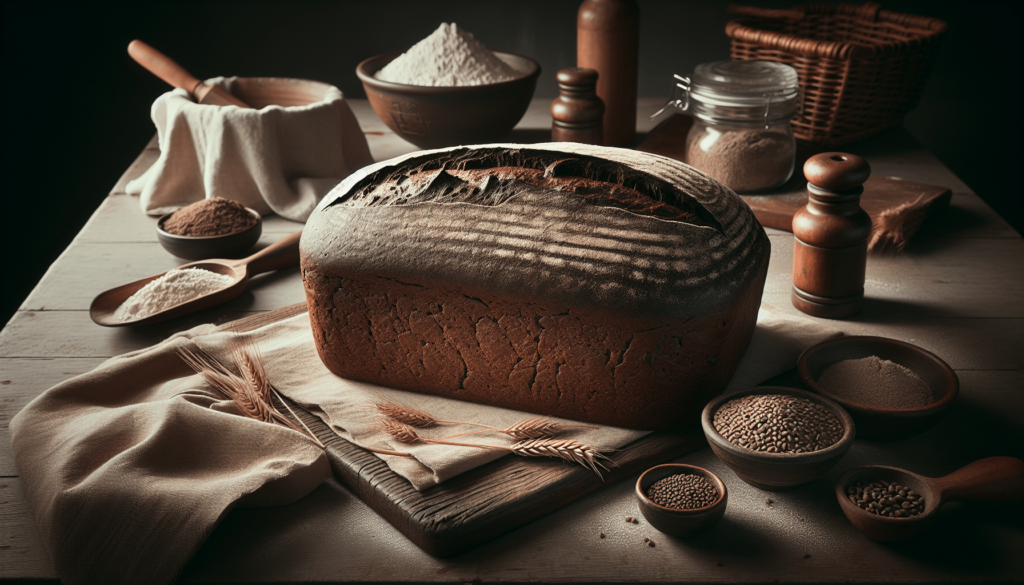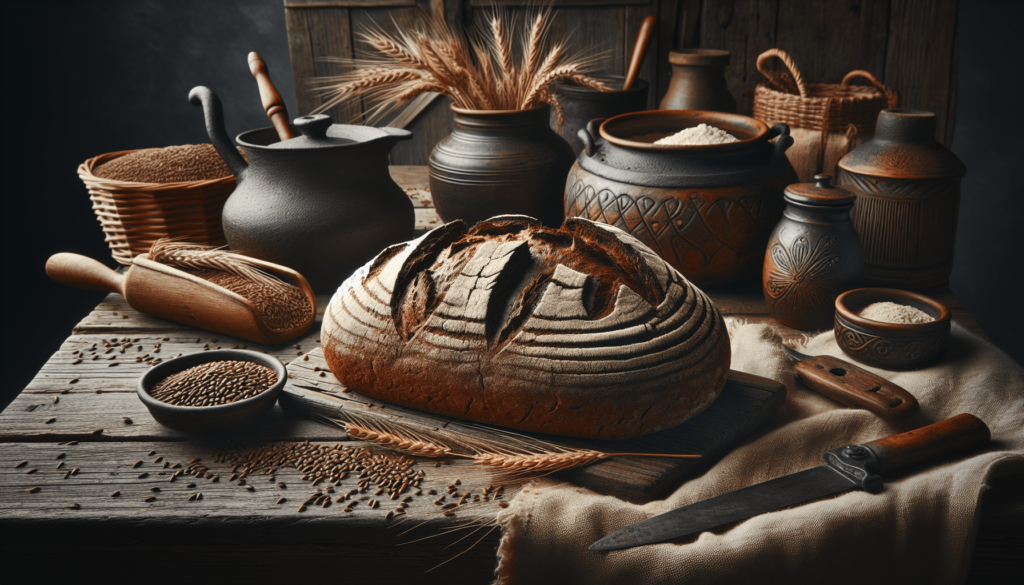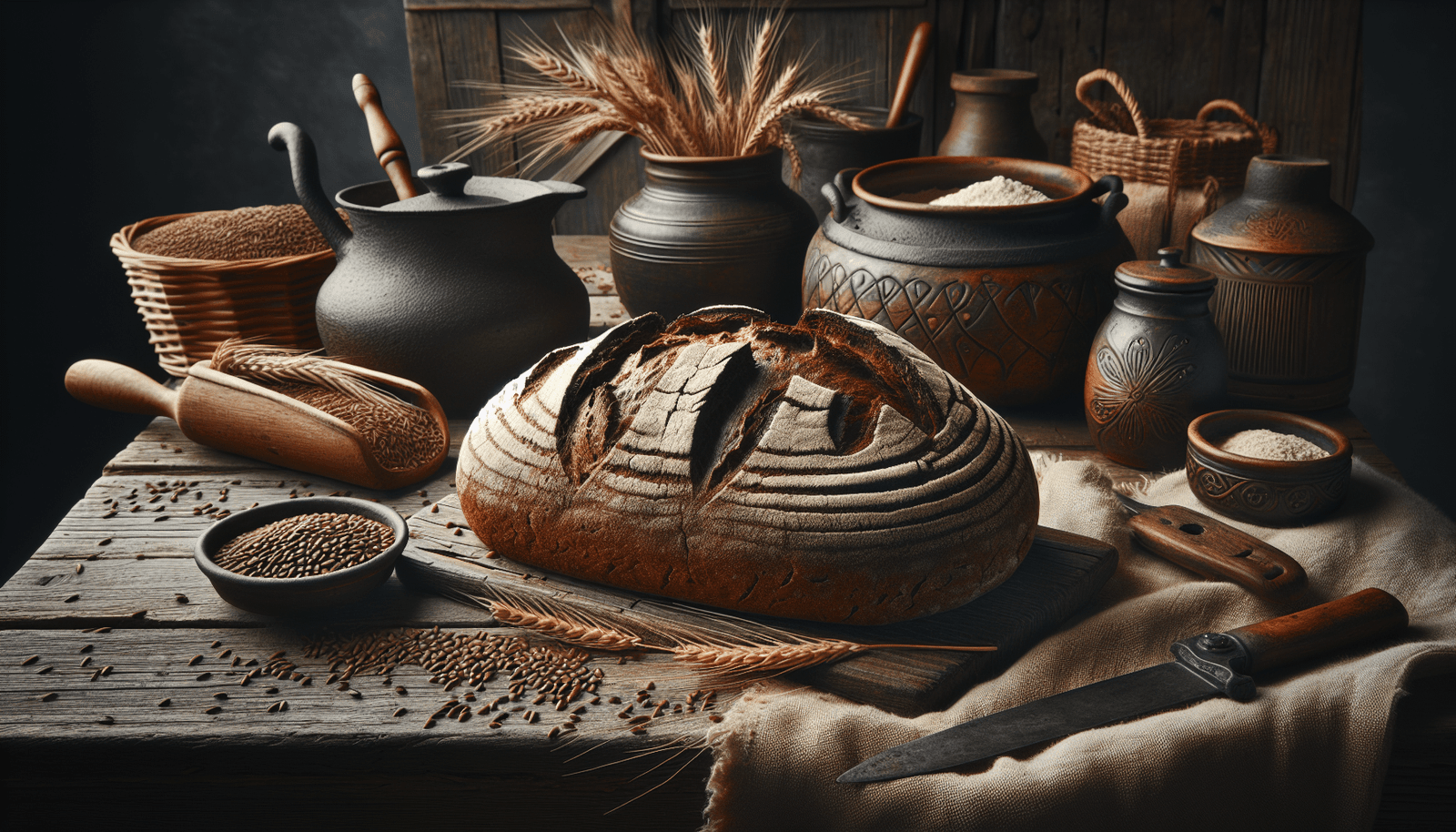Imagine biting into a warm and rustic loaf of Icelandic rye bread, its hearty flavor filling your mouth. This traditional recipe, rooted in Icelandic culture, has been passed down through generations, ensuring that each loaf brings a taste of history and tradition to your table. With simple ingredients and an easy-to-follow process, this article will guide you through the steps of creating this delicious bread, evoking the warmth and charm of Iceland in every bite. Get ready to embark on a culinary journey that will leave you craving more of this irresistible Icelandic specialty.

Icelandic Rye Bread Recipe
Icelandic rye bread is a delicious and culturally significant recipe that has been enjoyed for generations. This hearty bread is made using whole grain rye flour, dark rye flour, active dry yeast, salt, water, and molasses. The combination of these simple ingredients creates a flavorful and nutritious loaf of bread that can be enjoyed in various ways. Whether you are looking to explore Icelandic cuisine or simply want to try a new bread recipe, Icelandic rye bread is a fantastic choice. In this article, we will provide a comprehensive guide on how to make Icelandic rye bread, as well as explore its traditional significance, health benefits, and cultural relevance.
Ingredients
To make Icelandic rye bread, you will need the following ingredients:
- Whole grain rye flour
- Dark rye flour
- Active dry yeast
- Salt
- Water
- Molasses
These ingredients can typically be found in most grocery stores or specialty markets. It is important to use fresh ingredients to ensure the best flavor and texture in your bread.
Preparation
Preparing Icelandic rye bread involves several steps to ensure the perfect loaf. Here is a step-by-step guide to making this delicious bread:
Mixing the flours and yeast
In a large mixing bowl, combine the whole grain rye flour, dark rye flour, and active dry yeast. Mix them together well, ensuring that the yeast is evenly distributed throughout the flours. This step helps to activate the yeast and ensure that your bread rises properly.
Adding salt and water
Next, add salt to the flour mixture. Salt adds flavor to the bread and helps to control the fermentation process. Slowly pour in warm water, gradually mixing it into the flour mixture until a sticky dough forms. The warm water activates the yeast and helps the dough to rise.
Incorporating molasses
Once the dough has formed, it’s time to incorporate the molasses. Molasses adds a rich sweetness to the bread while also providing moisture and color. Slowly pour the molasses into the dough and continue to mix until it is fully incorporated.
Kneading the dough
Transfer the dough onto a lightly floured surface and begin kneading. Kneading helps to develop gluten in the dough, resulting in a lighter and more elastic texture. Continue to knead the dough for about 10-15 minutes or until it becomes smooth and elastic.
Letting the dough rise
Place the kneaded dough back into the mixing bowl and cover it with a clean kitchen towel. Allow the dough to rise in a warm environment for about 1-2 hours, or until it has doubled in size. This step is crucial for the fermentation process and contributes to the flavor and texture of the bread.
Shaping the dough
After the initial rise, gently punch down the dough and transfer it to a lightly greased loaf pan. Shape the dough into a loaf shape and smooth out the top. Cover the loaf pan with the kitchen towel and let the dough rise for another 30-45 minutes.
Baking the bread
Preheat the oven to 350°F (175°C). Once the dough has finished rising, place the loaf pan in the preheated oven and bake for approximately 45-50 minutes or until the bread is golden brown. You can test for doneness by tapping the bottom of the loaf – it should sound hollow.
Cooling and storing
Once the bread is baked, remove it from the oven and let it cool in the pan for a few minutes. Then, transfer the bread onto a wire rack to cool completely. Once cooled, store the bread in an airtight container to preserve its freshness.
Tips for Success
To ensure your Icelandic rye bread turns out perfectly, here are some tips to keep in mind:
Using fresh ingredients
Using fresh ingredients is crucial for achieving the best flavor and texture in your bread. Make sure your rye flour, yeast, and molasses are not expired and are of good quality.
Measuring accurately
Accurate measurements are essential in baking. Use measuring cups and spoons to measure the ingredients precisely. Be mindful of leveling off the flour and closely follow the recipe instructions.
Using warm water for yeast activation
When adding water to activate the yeast, make sure it is warm to the touch but not hot. Warm water helps to activate the yeast and kickstart the fermentation process.
Kneading until dough is elastic
Kneading the dough until it becomes smooth and elastic is vital for developing gluten. This gives the bread a lighter and more desirable texture. Be patient and continue kneading until the dough feels elastic.
Allowing enough time for rising
Proper fermentation requires sufficient time for the dough to rise and develop its flavors. Be patient and allow the dough to rise in a warm environment until it has doubled in size.
Placing dough in a warm environment
The ideal temperature for dough rising is around 80°F (26°C). If you don’t have a warm environment, you can place the dough near a preheating oven or use a proofing box to create the necessary conditions.
Monitoring baking time and temperature
Every oven is different, so it’s important to monitor the baking time and temperature. Keep an eye on the bread as it bakes and adjust the time or temperature if needed. The bread should be golden brown and sound hollow when tapped on the bottom.
Storing in an airtight container
To maintain the freshness of your Icelandic rye bread, store it in an airtight container. This will prevent it from drying out and help it stay delicious for longer.

Variations
One of the wonderful things about Icelandic rye bread is its versatility. Here are some variations you can try to add extra flavor and texture to your bread:
Adding seeds or nuts for extra flavor and texture
Consider adding a handful of seeds, such as sunflower seeds or flaxseeds, to the dough for added crunch and flavor. You can also incorporate chopped nuts, like walnuts or pecans, for a nutty twist.
Incorporating dried fruit or berries for a sweet twist
For a hint of sweetness, try adding dried fruit or berries to the dough. Dried cranberries, raisins, or chopped dates can provide a delightful burst of flavor in every bite.
Experimenting with different types of molasses
Molasses comes in various types, each with its unique flavor profile. Try using different types of molasses, such as light, dark, or blackstrap, to discover the flavor that suits your preferences best.
Trying different ratios of whole grain and dark rye flour
The combination of whole grain and dark rye flour can be adjusted to achieve different textures and flavors. Experiment with different ratios to find the balance that you enjoy the most.
Serving Suggestions
Once you have baked your Icelandic rye bread, it’s time to enjoy it in various ways. Here are some serving suggestions to inspire your culinary creativity:
Toast and top with butter and honey
For a simple and delicious treat, toast a slice of Icelandic rye bread and spread it with butter and a drizzle of honey. The slightly sweet flavor of the bread pairs perfectly with the richness of butter and the natural sweetness of honey.
Serve alongside soups or stews
Icelandic rye bread is the perfect accompaniment to a bowl of hearty soup or stew. The dense texture of the bread can be used to soak up the flavorful broth, adding an extra layer of satisfaction to your meal.
Enjoy with Icelandic smoked fish
In Iceland, it is common to enjoy rye bread with smoked fish, such as herring or salmon. The combination of the smoky fish and the earthy flavors of the bread creates a delectable taste experience.
Make open-faced sandwiches with various toppings
Icelandic rye bread is fantastic for creating open-faced sandwiches. Top a slice of bread with your favorite toppings, such as sliced cucumber, smoked meats, cheese, or pickled vegetables, for a delicious and satisfying meal.
Serve as a base for traditional Icelandic dishes
Icelandic rye bread can also be used as a base for traditional Icelandic dishes. For example, “plokkfiskur,” a traditional mashed fish dish, is often served on a bed of rye bread. The bread provides a sturdy base for the flavorful fish mixture.
Traditional Significance
Icelandic rye bread holds great traditional significance in Icelandic cuisine and culture. Here are some ways in which this bread is deeply rooted in Icelandic tradition:
A staple in Icelandic cuisine
Icelandic rye bread is considered a staple in Icelandic cuisine. It is often found on the dinner table and accompanies many meals.
Often baked in geothermal areas using hot springs
Traditionally, Icelandic rye bread was baked in geothermal areas using hot springs. The heat provided by the natural hot springs allowed the bread to bake slowly and develop a distinct flavor.
Ritualistic preparation during Christmas season
In Iceland, baking Icelandic rye bread is a ritualistic activity during the Christmas season. Families come together to prepare the bread, which is often enjoyed with butter and smoked lamb.
Symbol of warmth and comfort during winter months
Icelandic rye bread is seen as a symbol of warmth and comfort, particularly during the dark and cold winter months. Its aroma and taste evoke a feeling of coziness and contentment, bringing people together around the dining table.
Health Benefits
In addition to its delicious flavor, Icelandic rye bread offers several health benefits. Here are some reasons why incorporating this bread into your diet can be beneficial:
Rich in dietary fiber
Rye bread is rich in dietary fiber, which can help support a healthy digestive system and promote regularity. It can also help you feel fuller for longer and aid in weight management.
Low glycemic index
Compared to bread made from refined grains, Icelandic rye bread has a lower glycemic index. This means that it causes a slower and more gradual rise in blood sugar levels, making it a favorable choice for those monitoring their blood sugar levels.
Source of iron, magnesium, and B vitamins
Rye flour used in Icelandic rye bread is a good source of essential minerals such as iron and magnesium, as well as B vitamins like thiamin and niacin. These nutrients are important for energy production, brain function, and overall well-being.
May support gut health and digestion
The dietary fiber found in Icelandic rye bread acts as a prebiotic, providing nourishment for beneficial bacteria in the gut. This can help support a healthy gut microbiome and promote optimal digestion.
Cultural Relevance
Icelandic rye bread holds significant cultural relevance in Iceland. Here are some ways in which this bread is deeply intertwined with Icelandic culture:
Strong connection to Icelandic identity
Icelandic rye bread is deeply ingrained in Icelandic identity and is considered a quintessential part of Icelandic cuisine. Its preparation and consumption are a source of pride for many Icelanders.
Passed down through generations
The recipe for Icelandic rye bread has been passed down through generations in Icelandic families. This breadmaking tradition is often taught from parents to children, ensuring its continued legacy.
Celebrated during festivals and holidays
Icelandic rye bread is celebrated during festivals and holidays, particularly Christmas. Baking this bread is a cherished tradition that brings families together and creates a sense of community.
Showcased in traditional Icelandic bakeries
Traditional Icelandic bakeries often have Icelandic rye bread as a signature offering. These bakeries serve as a gathering place for locals and tourists alike to experience the taste and tradition of this unique bread.
Adaptations for Special Dietary Needs
For individuals with special dietary needs, there are several adaptations that can be made to the Icelandic rye bread recipe. Here are some ideas to cater to specific dietary restrictions:
Gluten-free version using alternative flours
For those following a gluten-free diet, Icelandic rye bread can be made using alternative flours, such as gluten-free oat flour or a combination of almond flour and tapioca flour. These flours provide a similar texture and flavor while being gluten-free.
Vegan option using plant-based substitutes
To make Icelandic rye bread vegan-friendly, you can replace ingredients such as honey or butter with plant-based alternatives such as agave syrup or coconut oil. This allows individuals following a vegan lifestyle to enjoy this traditional recipe.
Reduced-sodium version for those on low-salt diets
If you are on a low-salt diet, you can reduce the amount of salt used in the bread recipe. While salt adds flavor, you can adjust the amount to meet your specific dietary needs.
Sugar-free alternative for individuals with dietary restrictions
For individuals with dietary restrictions, such as those with diabetes, you can explore sugar-free alternatives to molasses. There are natural sugar substitutes available that can provide a similar level of sweetness without the impact on blood sugar levels.
Conclusion
Icelandic rye bread is a delicious and culturally significant recipe that has been enjoyed in Iceland for generations. Its simple ingredients and traditional preparation make it a unique and satisfying bread to try. Whether you choose to serve it alongside soups or stews, enjoy it with Icelandic smoked fish, or experiment with different variations, Icelandic rye bread is sure to delight your taste buds. Moreover, its health benefits, cultural relevance, and adaptations for special dietary needs make it a versatile bread that can be enjoyed by a wide range of people. So, roll up your sleeves, gather your ingredients, and embark on a culinary journey to experience the warmth and tradition of Icelandic rye bread.


